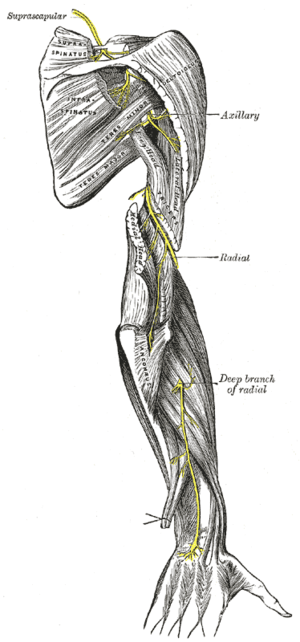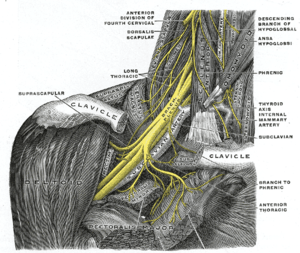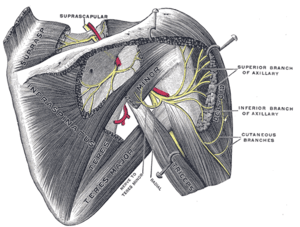Suprascapular nerve
The suprascapular nerve is a nerve that arises from the brachial plexus. It is responsible for the innervation of some of the muscles that attach on the scapula, namely the supraspinatus and infraspinatus muscles.
| Suprascapular nerve | |
|---|---|
 The suprascapular, axillary, and radial nerves. (Suprascapular labeled at upper left.) | |
 The right brachial plexus with its short branches, viewed from in front. (Suprascapular labeled at upper left.) | |
| Details | |
| From | C5–C6 of brachial plexus |
| Innervates | supraspinatus, infraspinatus |
| Identifiers | |
| Latin | nervus suprascapularis |
| TA | A14.2.03.014 |
| FMA | 37025 |
| Anatomical terms of neuroanatomy | |
Structure
The suprascapular nerve arises from the upper trunk of the brachial plexus which is formed by the union of the ventral rami of the fifth and sixth cervical nerves. After branching from the upper trunk, the nerve passes across the posterior triangle of the neck parallel to the inferior belly of the omohyoid muscle and deep to the trapezius muscle. It then runs along the superior border of the scapula, passes through the suprascapular notch inferior to the superior transverse scapular ligament and enters the supraspinous fossa.[1] It then passes beneath the supraspinatus, and curves around the lateral border of the spine of the scapula through spinogleniod notch to the infraspinous fossa.
Function
The suprascapular nerve is a mixed peripheral nerve containing motor and sensory components.
Motor innervation
- Supraspinatus muscle[1]
- Infraspinatus muscle (through the spinoglenoid notch)[1]
Sensory innervation
- Acromioclavicular joint[1]
- Glenohumeral joint[1] (shoulder joint)
In the supraspinous fossa it gives off two branches to the supraspinatus muscle and in the infraspinous fossa it gives off two branches to the infraspinatus muscle.
Clinical significance
- Suprascapular paralysis, causing back pain, problems with abduction and external rotation of the humerus, and wasting away of supraspinatus and infraspinatus.
Supraspinatus muscle helps in 0°-15° arm abduction. And Infraspinatus helps in lateral rotation(external rotation) of humerus.
Additional images
 Suprascapular and axillary nerves of right side, seen from behind.
Suprascapular and axillary nerves of right side, seen from behind. Brachial plexus with courses of spinal nerves shown
Brachial plexus with courses of spinal nerves shown
External links
- Suprascapular_nerve at the Duke University Health System's Orthopedics program
References
This article incorporates text in the public domain from page 932 of the 20th edition of Gray's Anatomy (1918)
- Avery, BW; Pilon, FM; Barclay, JK (November 2002). "Anterior coracoscapular ligament and suprascapular nerve entrapment". Clinical anatomy (New York, N.Y.). 15 (6): 383–6. doi:10.1002/ca.10058. PMID 12373728.